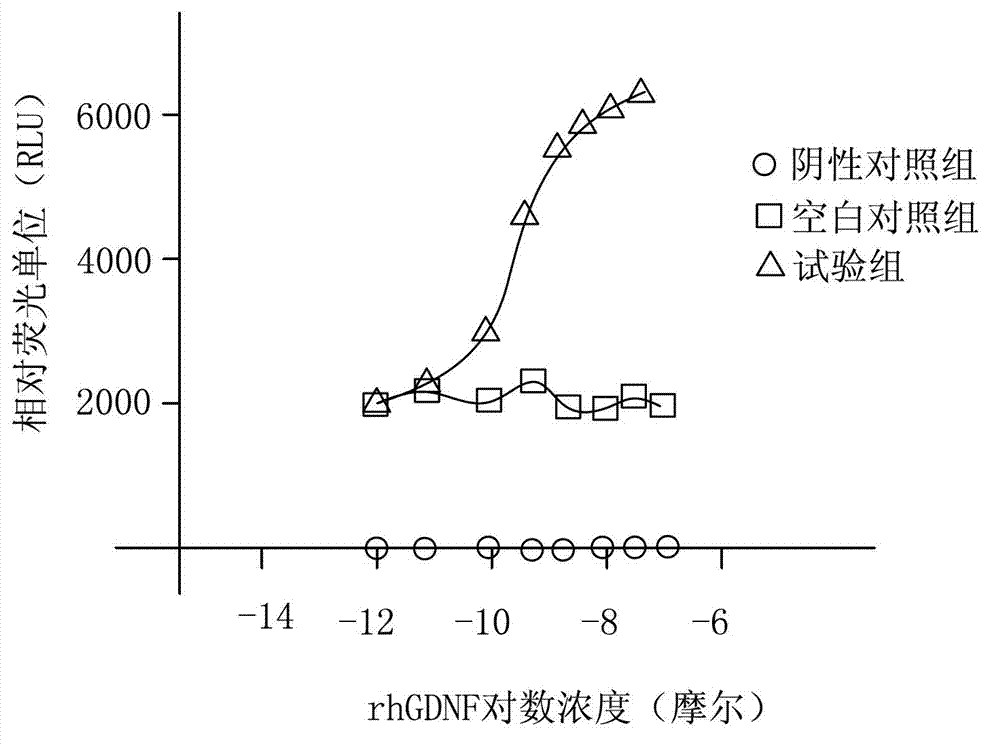Cytological method for assaying activity of rhGDNF (recombinant human Glial cell line-Derived Neurotrophic Factor)
A neurotrophic factor and glial cell technology, applied in the field of bioengineering, can solve the problems of lack of cytological methods for the detection of recombinant human glial cell-derived neurotrophic factor, and achieve accurate and reliable results
- Summary
- Abstract
- Description
- Claims
- Application Information
AI Technical Summary
Problems solved by technology
Method used
Image
Examples
Embodiment 1
[0039] A cytological method for measuring the activity of recombinant human glial cell-derived neurotrophic factor, comprising the steps of:
[0040] S1. Using pcDNA3.1- as the expression vector, use restriction enzymes XhoI and Not I to linearize the vector, and then use T4DNA ligase to connect the hGFRα1 cDNA to pcDNA3.1 to construct the expression plasmid pcDNA3.1-hGFRα1, and then use Prepare HEK293 cells expressing hGFRα1 by transfection, the detailed steps are:
[0041] A. Add 2μg pcDNA3.1-hGFRα1 to 110μl Opti-MEM medium, mix gently and place at room temperature for later use;
[0042] B. Add 15 μl Lipofectamine (DNA transfection reagent) to 150 μl Opti-MEM medium, mix gently and place at room temperature for later use;
[0043] C, mixing the DNA-Lipofactamine liquid of step A and step 2B to obtain a DNA-Lipofectamine mixture;
[0044] D. Place the DNA-Lipofectamine obtained in step C at room temperature (25°C) for 30 minutes;
[0045] E. Then add 320 μl of Opti-MEM me...
Embodiment 2
[0061] Other steps are the same as in Example 1, except that in step S3, rhGDNF to be tested is made into a solution to be tested with a concentration of 1.0 ng / μl.
[0062] Results: Comparing F1 and F2, it is found that F1 and F2 are basically equal, which means that the rhGDNF to be tested has no activity.
Embodiment 3
[0064] Other steps are the same as in Examples 1 and 2, except that in step S3, the rhGDNF to be tested is made into a solution to be tested with a concentration of 83.3 ng / μl.
[0065] Results: Comparing F1 and F2, and finding that F1
PUM
| Property | Measurement | Unit |
|---|---|---|
| cover factor | aaaaa | aaaaa |
Abstract
Description
Claims
Application Information
 Login to View More
Login to View More - R&D
- Intellectual Property
- Life Sciences
- Materials
- Tech Scout
- Unparalleled Data Quality
- Higher Quality Content
- 60% Fewer Hallucinations
Browse by: Latest US Patents, China's latest patents, Technical Efficacy Thesaurus, Application Domain, Technology Topic, Popular Technical Reports.
© 2025 PatSnap. All rights reserved.Legal|Privacy policy|Modern Slavery Act Transparency Statement|Sitemap|About US| Contact US: help@patsnap.com

